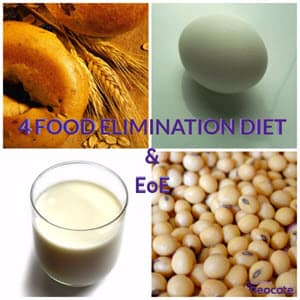 The 4-food elimination diet vs 6-food elimination diet
The 4-food elimination diet vs 6-food elimination diet
The 4-food elimination diet is a new concept. The 6-food elimination diet has been used for a number of years to help EoE (eosinophilic esophagitis) patients of all ages figure out their trigger foods. Now research suggests the 4-food elimination diet can be an effective option to manage EoE.
6-food elimination diet
On the 6-food elimination diet, a person must avoid milk, wheat, soy, egg, peanut, tree nuts, fish, and shellfish. If you count all of those foods, it is actually 8 and not 6, but I digress. On the 4-food elimination diet, a person is allowed to continue to eat peanuts, tree nuts, fish, and shellfish (as long as there are no other types food allergies such as anaphylaxis) but still must avoid milk, wheat, soy, and egg. Anyone that has ever tried to avoid multiple major food groups will agree that this is huge news. Beware of the potential nutritional pitfalls so this diet can still be balanced and healthy.
Nutrients and the 4-food elimination diet
While avoiding milk and dairy products, the nutrients at the greatest risk for deficiency are calcium, vitamin D, phosphorus, vitamin B12, riboflavin, and niacin. Some alternative food sources of these nutrients include spinach, collard greens, kale (think dark, leafy green vegetables), oatmeal (as long as it has not had cross-contact with wheat), asparagus, pork, chicken, beef, salmon (and other fatty fish), sardines, peanuts, fortified beverages, and fortified wheat-free breakfast cereals.
Wheat is an important source of thiamin, niacin, vitamin E, zinc, and selenium in the typical American diet. Alternative food sources of these nutrients are pork, beef, oysters, salmon (and other fatty fish), fish such as tuna and cod, raisins, sunflower seeds, mushrooms, asparagus, collard greens, tree nuts, and fortified wheat-free breakfast cereals.
Soy and its replacements
Soy provides vitamin E, choline, iron, and potassium in the diet. Alternative food sources of these nutrients include sunflower seeds, plant oils, raisins, oranges, bananas, melons, tomato, potato, squash, broccoli, cauliflower, beef, oysters, clams, salmon, grape juice, peanuts, tree nuts, and fortified wheat-free breakfast cereals.
Eggs are an important source of vitamin D, vitamin B12, vitamin A, riboflavin, niacin, choline, and iron. Alternative food sources of these nutrients include beef, pork, chicken, fish and fatty fish such as salmon, fortified beverages, green and dark green leafy vegetables, carrots, squash, broccoli, cauliflower, cabbage, cantaloupe, apricot, mango, grape juice, raisins, peanuts, and fortified wheat-free breakfast cereal.
Before you get overwhelmed thinking about all of these different foods
Take a step back and notice that these foods are colorful and come from the protein, fruits, and vegetables food groups. Specifically, what are these allowable foods that require removal in the 6 food elimination diet? These are fish, shellfish, plant oils, peanuts, tree nuts, and seeds. These are the hallmark foods of a Mediterranean-style eating pattern. The same basic principles of a healthy and balanced diet apply to an elimination diet as with any other diet. People should not eat meals on a regular basis that are all one color or are bland colors; beige is boring. Even while avoiding 4 major types of food, it is possible to keep a variety in the diet.
You may find this Mediterranean eating pattern listed as the DASH diet, Mediterranean diet, Heart Healthy Diet…among others.
Remember, you will still need to avoid milk and all dairy, wheat, soy, and egg.
Adjusting to a new diet can take time. If a Mediterranean style eating pattern is completely new and different to you and your family, allow yourself more time to adjust and find alternative foods. It may also be necessary to include a hypoallergenic amino acid-based formula as a supplement to avoid unintentional weight loss and nutritional deficiencies. Be honest with yourself and your doctor about what you are and are not willing to do while on an elimination diet. These diets help manage EoE and improve quality of life…even though it may feel like they do just the opposite.
Members of your EoE healthcare team will evaluate the need for a 4-food elimination diet. Do not be afraid to ask questions when you go about identifying what foods trigger your inflammation and EoE symptoms.
Our guest blog today comes from Alexia Beauregard. Alexia Beauregard is a Registered Dietitian. The inspiration for this blog is based on her extensive experience working with the families of patients diagnosed with EoE.
Last update on January 24, 2019






